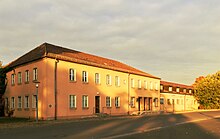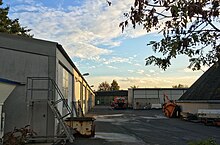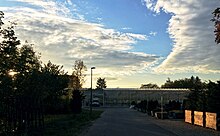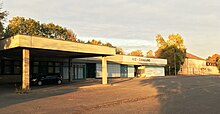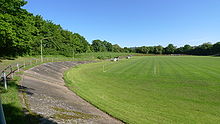Nuremberg Marienberg Airport
| Nuremberg Marienberg Airport | |
|---|---|
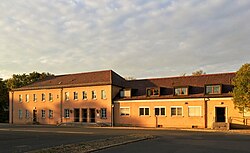
|
|
| Characteristics | |
| Coordinates | |
| Height above MSL | 319 m (1047 ft ) |
| Transport links | |
| Distance from the city center | 4 km north of Nuremberg |
| Street | Max-von-Müller-Platz |
| train | Regional train , tram |
| Local transport | City bus Nuremberg |
| Basic data | |
| opening | August 20, 1933 |
| closure | April 17, 1945 |
| operator | City of Nuremberg |
| surface | 140 ha |
| Terminals | 1 |
| Passengers | 35,076 (1937) |
| Air freight | 643 (1937) |
| Employees | 25 (1941) |
| Start-and runway | |
| 09/27 | 1400 m |
The Nuremberg-Marie Berg airport was from 20 August 1933 to the autumn of 1940, the international airport of the Franconian city of Nuremberg . From the mobilization on August 28, 1939 until the liberation of Nuremberg by the armed forces of the United States on April 14, 1945, the airfield served only the purposes of the Air Force and was not reopened after the almost complete destruction of the buildings in the Second World War .
The Marienberg Park is located on the site of the former airport .
Location and transport links
Nuremberg-Marienberg Airport was located about four kilometers north of Nuremberg's city center in the Marienberg district of the same name . The airport site was tangentially touched by today's Kilian - or Großreuther Straße in the south and today's Marienbergstraße in the north, and Senefelderstraße led to the forecourt of the airport, Max-von-Müller-Platz . The Bessemerstraße tram stop - today only served by bus lines - was located around 750 meters east of the airport . Furthermore, the northeast train station , which is connected to the Graefenbergbahn and the Ringbahn and since 1996 to the underground , is about one kilometer away to the southeast.
history
Predecessor airport
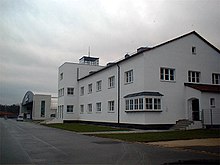
In 1926, the Fürth-Nürnberg airport in Atzenhof was threatened with closure by the Bavarian Ministry of Commerce due to buildings in need of renovation, necessary expansions for military use and infrastructure that did not meet the requirements of modern flight operations, despite increasing passenger numbers. The necessary measures to remedy the grievances should be implemented within four months. The investments would have amounted to around half a million Reichsmarks, of which the city of Fürth would have had to finance 2/3 and the city of Nuremberg 1/3 according to the ownership . However, since Fürth was not financially able to do so and the Nuremberg residents criticized the poor public transport connections and the great distance of twelve kilometers from the city center, the problem was discussed in an extended meeting of the Nuremberg city council on August 31, 1926. The Lord Mayor of Nuremberg, Hermann Luppe, hesitated at first due to financial considerations, since Fürth had a 2/3 stake in the airport, to approve a new building in the city of Nuremberg. However, since the city of Fürth made it clear that as a medium-sized town it could not afford to finance an international airport and large parts of the Nuremberg population and the Bavarian authorities favored an airport in the Nuremberg city area, the city council decided on February 16, 1927 to build a new building. On April 21, 1927, the cities of Nuremberg and Fürth agreed on a reallocation of the costs of Atzenhof airport, which should remain in operation until the new building opened. In future, Nuremberg paid 4/5 of the material and personnel costs and 3/4 of the route subsidies according to the number of inhabitants, but nevertheless agreed to keep the name Fürth-Nürnberg Airport for the time being. On December 8, 1927, the Bavarian state government also approved the new building plans. From October 1, 1928, due to financial difficulties in the city of Fürth, the city of Nuremberg continued to run the airport on its own and renamed it Nuremberg-Fürth Airport .
construction
Choice of location
The Bavarian Ministry of Commerce only approved the plans for the new building on the condition that an application for the opening of a business had to be submitted by May 1, 1930. Since the airport was to be located close to the city, the south of the city due to its strong industrialization, the west due to the planned new port and river cuts, as well as the Reichswald in the east were also out of the question, a suitable area was only found in the north. It extends between the districts of Großreuth behind the Veste and Marienberg , is four kilometers from the city center and was discussed as the location of a Nuremberg airport as early as 1914 alongside Großreuth near Schweinau and Wetzendorf . According to traffic advisor Wilhelm Weigel and construction advisor Walter Brugmann, the site should meet the requirements of a modern airport with dimensions of 1000 by 1000 meters.
Land acquisition
The land acquisition should be carried out freehand and, if possible, without expropriations . 18 of the 100 hectares required were already in municipal ownership and a further 76 hectares could be acquired by 1929 from the state forest and larger private owners in the north and farmers in the southern area. In five cases, the Bavarian Ministry of the Interior had to confiscate a total area of 2.6 hectares by means of expropriation in February 1926. An area of around one hectare in the northeast of the site, which housed the Ziegelstein cemetery and a small wooded area, was initially retained. The area to the south of the airport area, which comprised about seven hectares, was also already owned by the city and was intended to be used for the construction of administrative buildings, aircraft hangars, as well as parking lots and access roads.
Field work
The first new building at the airport was a radio station that the city of Nuremberg had built between Thon and Buch with the support of the Reich Ministry of Transport . In the meantime this was still used for the airport in Atzenhof. Nuremberg took care of the land acquisition, construction and maintenance of the radio station, while the German Reich financed the technology and personnel. In September 1928, the City Garden Authority began leveling the area on Marienberg and removing obstacles by laying light rail tracks. The project was also used as a job creation measure, so that in addition to the workers from the gardening department, a large number of unemployed people were also employed. The quantities of household waste and rubble deposited here over the past five years were used to fill ditches and swamps and then to cover them with humus, level them and grass them by autumn 1929. The area was also surrounded with a fence. The preparatory work, which employed around 1,000 people, moved 225,000 cubic meters of soil and leveled 27 hectares, was thus completed.
Great Depression
Although the city council approved the construction of the buildings and the necessary transport infrastructure in 1929, the cost of which was estimated at around 1.2 million Reichsmarks, the further deteriorating financial situation in the course of the global economic crisis prevented the implementation of the plans. Originally planned was the implementation of four iron and steel structures, 40 meter deep halls with 60 × 10 meter gates. For cost reasons, however, only a hall with workshops and an attached police observation tower with lounges and offices as well as an administration building with 2000 square meters were to be built.
The airfield was temporarily used for a zeppelin landing for the first time on May 10, 1931, which was attended by well over 100,000 people. A second time it served a major flight day on June 5, 1932, on which squadron flights, aerobatic demonstrations, glider landings, parachute jumps and an airplane race were offered. The parachute pilot Lisl Schwab caused a scandal as she flew over the event area with an advertising banner for the National Socialist newspaper Der Stürmer . Due to a thunderstorm, significantly fewer took part this year with only 30,000 visitors.
completion
The new National Socialist city administration began to erect the remaining high-rise buildings on May 28, 1933, despite the continued financial strain, and carried out the work in a period of less than three months until mid-August 1933. The official opening took place on August 20th. The reason for the quick execution of the work was the upcoming date for the Reich Party Rally of Victory , which will take place in the first week of September and at which Hitler was to land at the new airport. Already from May 20 to June 16, 1933, the then largest aircraft in practical air traffic, a Junkers G 38 , flew on the regular scheduled flight from Berlin via Leipzig / Halle and Nuremberg / Fürth to Munich instead of Atzenhofer, the Marienberg airport on the way - and return flight. The premiere landing, attended by local Nazi politicians with Mayor Willy Liebel , attracted around 4,000 spectators and was staged as a symbolic and media-effective event for the airport expansion. The morning landings in the following weeks were attended by hundreds, mostly school classes.
Installation
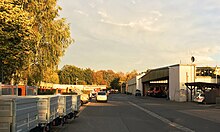
The opening originally scheduled for August 13, 1933, could not take place due to a simultaneous Nazi event on the Hesselberg and had to be postponed by a week to August 20. Due to the short-term postponement of the date, numerous invited guests could not take part in the opening event, at which all air traffic was relocated from Atzenhof and aerobatics were held. Just a few days later, however, due to the Nazi party rallies taking place on August 31 to September 3, air traffic was relocated to Fürth again before operations were resumed. An offer that the city had received from the Süddeutsche Lufthansa and that provided for the takeover of airport administration, like the one in Munich, was rejected by the city council. Instead, Nuremberg itself invested 450,000 Reichsmarks between 1935 and 1937 in an extension of the barracks and workshop extensions as well as a control tower for air traffic control and two runway lights. Between 1933 and 1937, both passenger and freight volumes rose from 14,721 to 35,076 passengers and from 41 to 643 tons of freight per year. The flight plans list the following connections from 1934 until the discontinuation of the regular service - due to the mobilization on August 28, 1939:
- 1934 to 1939: Nuremberg - Hanover - Bremen [ Lufthansa ]
- 1934 to 1939: Stuttgart - Nuremberg - Dresden - (from 1935: Breslau ) [Lufthansa]
- 1934 to 1939: Munich - Nuremberg - Essen - (from 1935: Düsseldorf ) [Lufthansa]
- 1934 to 1939: Nuremberg - Frankfurt am Main - (from 1935: Dortmund ) [Lufthansa]
- 1934 to 1940: Berlin - Nuremberg (- Munich) [Lufthansa]
- 1934 to 1939: Paris - Nuremberg - Prague [ Air France ]
- 1935 to 1936: London - Cologne - Nuremberg - Vienna - Budapest [ Imperial Airways ]
- 1936 to 1939: Nuremberg - Erfurt - Magdeburg - Hamburg [Lufthansa]
- 1937 to 1939: Munich - Nuremberg - Cologne - Amsterdam [Lufthansa]
- 1937 to 1939: Munich - Nuremberg - Frankfurt am Main - Brussels - London [Lufthansa]
Only the regular service between the "Reich capital" Berlin , the " city of the Nazi party rallies " Nuremberg and the " capital of the movement " Munich was maintained until autumn 1940, before the airport was only used for military purposes.
Second World War
Since September 1, 1939, the airport was confiscated and subordinated to the Luftgaukommando XII. An air base was also set up. However, the city was still responsible for the maintenance of the facilities and their care and had to obey the orders of the Luftgau Command. With the final suspension of the last scheduled service in the autumn of 1940, the airport was only used for the purposes of the Air Force, mainly for pilot training. At the end of 1938, a 40-hectare extension was started in the west of the area, which the Horticultural Office, together with the Water and Bridge Construction Office, drained and leveled from 1940 to 1941. In the spring of 1942, a first section in the south could go into operation, with which the runway was extended to 1.4 km. In addition to the caretaker and seven to nine German employees, twelve to 20 foreign employees, mostly French and from July 1942 also Russian prisoners of war, did work there.
The airport was a frequent target during the air raids on Nuremberg, but the damage was always repaired immediately. In the bombings on August 10 and 11, 1943, the airport building, the restaurant and several accommodation barracks were completely destroyed. The vehicle hangars and the command building erected by the Wehrmacht were also badly damaged by fires. A makeshift building was then erected by Russian and Italian prisoners of war in the middle of the destroyed administration building to accommodate the air traffic control and other imperial offices. Although the Nuremberg Aviation School was relocated with the bombing of 1943, the Fürth Aviation School was already being used for flight exercises at the end of December 1943. In the first half of 1944, over a thousand take-offs and landings were recorded every month. Even after further heavy bombings on October 3 and 25/26. November 1944 as well as on January 2 and 20/21. February 1945 the destroyed buildings were restored and the bomb craters filled. Only with the liberation of Nuremberg by the US armed forces on April 17 ended in 1945, the operations, as they initially on industrial airport Fuerth , who later became industry airport Nuremberg-Fuerth , stationed and then moved to the airfield Atzenhof.
New airfield
Until the opening of the new airport , located two kilometers north in the Kraftshof district , the Nuremberg-Fürth industrial airport on the Fürth Hardhöhe served as a landing pad for Nuremberg's international air traffic from 1950 to 1955.
Reuse
Marienberg Park
The Volkspark Marienberg, laid out between 1959 and 1973, is now the second largest park in Nuremberg with 120 hectares and offers not only allotment gardens , a large playground, public barbecue areas, a fitness trail and play and sunbathing areas in summer, but also toboggan mountains and cross-country skiing trails in winter. In the northwest area of the facility there is a small pond with the Marienbergsee, which is also often used for ice skating in winter.
SÖR depot
The only remaining buildings of the airport are today in the depot of the Nuremberg Public Service Service (SÖR). Two hangars from the 1930s are still used today as one of two municipal depots for winter clearance vehicles. One hangar was converted into an assembly and maintenance hall in the 1950s, while the other is used as a storage hall. A third hangar, which had also survived the war, was demolished in the 1990s. The site also houses the former command building, which was built and occupied by the Reich Aviation Ministry in spring 1942 and which today serves as the SÖR's administration building. There are also road salt depots and several newly built vehicle hangars on the area. A garage from the 1930s has also been preserved. There is a tank system in front of it today. Before the SÖR used the site, it was used by the city cleaning and trucking office since 1945.
City gardening
To the north of the SÖR depot is now the Noris Inklusion natural experience nursery . In 1998, Noris Inklusion GmbH took over the site and the operation of the municipal nurseries and today employs 90 people with disabilities on an area of around five hectares, who cultivate and grow ornamental plants and herbs for bulk buyers and private customers. The employees also maintain around 100 hectares of park and garden areas in the city of Nuremberg and private companies. The vegetables and herbs grown there have been certified organic since 2011.
Vehicle registration
To the west of the command building of the SÖR depot, there is now a vehicle registration office on the area.
Sports fields
On the north-eastern edge of the former airport area, the Ziegelsteiner sports clubs Tuspo Nürnberg and ASN Pfeil Phönix have expanded their club premises , which are directly adjacent to one another, at the same time as the Marienberg Park is being laid out by around 30,000 square meters to the west with football pitches.
Traffic figures
| Year of operation | Passenger volume | Air freight t |
|---|---|---|
| 1933 | 14,721 | 41 |
| 1937 | 35,076 | 643 |
literature
- Bernd Windsheimer (ed.): 50 years of Nuremberg Airport. History of aviation in Nuremberg . Sandberg Verlag, Nuremberg 2005, ISBN 3-930699-40-0 , pp. 42-53
Web links
- The old Nuremberg airport was in the Marienberg park
- Sör fleet: Military planes once landed here
- Historic moments - The dream of flying: Looking for clues with VAG
- History of the Nuremberg airfield
Individual evidence
- ↑ a b c d e f Bernd Windsheimer (ed.): 50 years of Nuremberg Airport. History of aviation in Nuremberg . Sandberg Verlag, Nuremberg 2005, ISBN 3-930699-40-0 , p. 43
- ↑ a b Bernd Windsheimer (ed.): 50 years of Nuremberg Airport. History of aviation in Nuremberg . Sandberg Verlag, Nuremberg 2005, ISBN 3-930699-40-0 , p. 49
- ↑ a b c d e Bernd Windsheimer (ed.): 50 years of Nuremberg Airport. History of aviation in Nuremberg . Sandberg Verlag, Nuremberg 2005, ISBN 3-930699-40-0 , p. 52
- ↑ a b Bernd Windsheimer (ed.): 50 years of Nuremberg Airport. History of aviation in Nuremberg . Sandberg Verlag, Nuremberg 2005, ISBN 3-930699-40-0 , p. 50
- ↑ a b Bernd Windsheimer (ed.): 50 years of Nuremberg Airport. History of aviation in Nuremberg . Sandberg Verlag, Nuremberg 2005, ISBN 3-930699-40-0 , p. 53
- ↑ a b c Wiltrud Fischer-Pache: Marienberg . In: Michael Diefenbacher , Rudolf Endres (Hrsg.): Stadtlexikon Nürnberg . 2nd, improved edition. W. Tümmels Verlag, Nuremberg 2000, ISBN 3-921590-69-8 , p. 670 ( complete edition online ).
- ↑ Bernd Windsheimer (ed.): 50 years of Nuremberg Airport. History of aviation in Nuremberg . Sandberg Verlag, Nuremberg 2005, ISBN 3-930699-40-0 , p. 34
- ↑ Bernd Windsheimer (ed.): 50 years of Nuremberg Airport. History of aviation in Nuremberg . Sandberg Verlag, Nuremberg 2005, ISBN 3-930699-40-0 , p. 35
- ↑ Bernd Windsheimer (ed.): 50 years of Nuremberg Airport. History of aviation in Nuremberg . Sandberg Verlag, Nuremberg 2005, ISBN 3-930699-40-0 , p. 36
- ↑ a b Bernd Windsheimer (ed.): 50 years of Nuremberg Airport. History of aviation in Nuremberg . Sandberg Verlag, Nuremberg 2005, ISBN 3-930699-40-0 , p. 44
- ↑ Bernd Windsheimer (ed.): 50 years of Nuremberg Airport. History of aviation in Nuremberg . Sandberg Verlag, Nuremberg 2005, ISBN 3-930699-40-0 , p. 45
- ↑ a b Bernd Windsheimer (ed.): 50 years of Nuremberg Airport. History of aviation in Nuremberg . Sandberg Verlag, Nuremberg 2005, ISBN 3-930699-40-0 , p. 46
- ↑ Bernd Windsheimer (ed.): 50 years of Nuremberg Airport. History of aviation in Nuremberg . Sandberg Verlag, Nuremberg 2005, ISBN 3-930699-40-0 , p. 46f.
- ↑ Bernd Windsheimer (ed.): 50 years of Nuremberg Airport. History of aviation in Nuremberg . Sandberg Verlag, Nuremberg 2005, ISBN 3-930699-40-0 , p. 47
- ↑ Bernd Windsheimer (ed.): 50 years of Nuremberg Airport. History of aviation in Nuremberg . Sandberg Verlag, Nuremberg 2005, ISBN 3-930699-40-0 , p. 48
- ↑ Bernd Windsheimer (ed.): 50 years of Nuremberg Airport. History of aviation in Nuremberg . Sandberg Verlag, Nuremberg 2005, ISBN 3-930699-40-0 , p. 50f.
- ↑ Bernd Windsheimer (ed.): 50 years of Nuremberg Airport. History of aviation in Nuremberg . Sandberg Verlag, Nuremberg 2005, ISBN 3-930699-40-0 , p. 52f.
- ↑ Bernd Windsheimer (ed.): 50 years of Nuremberg Airport. History of aviation in Nuremberg . Sandberg Verlag, Nuremberg 2005, ISBN 3-930699-40-0 , p. 59
- ↑ Bernd Windsheimer (ed.): 50 years of Nuremberg Airport. History of aviation in Nuremberg . Sandberg Verlag, Nuremberg 2005, ISBN 3-930699-40-0 , p. 59
- ↑ Sör fleet: Military aircraft once landed here on nordbayern.de, from May 29, 2017, accessed on October 2, 2018
- ↑ Organic herbs, flowers and encounters on nuernberg.de, accessed on October 16, 2018

